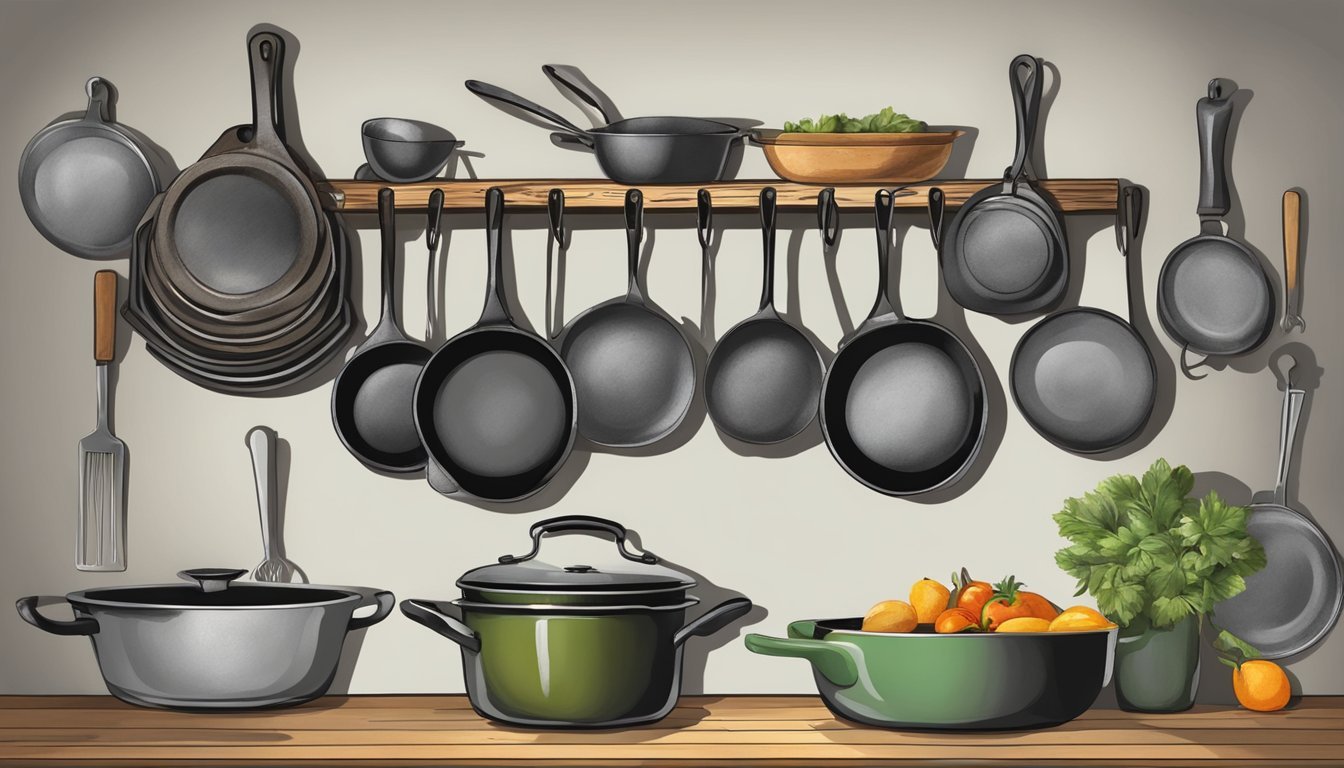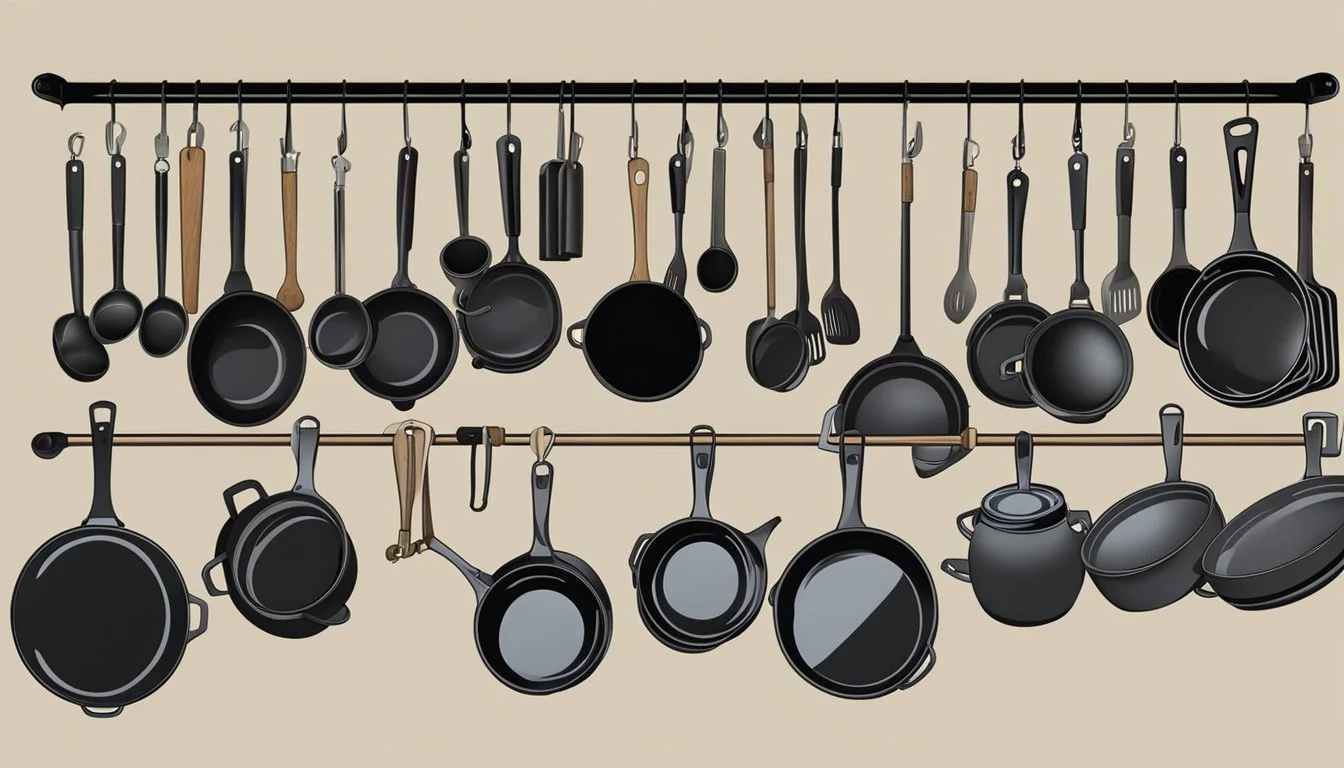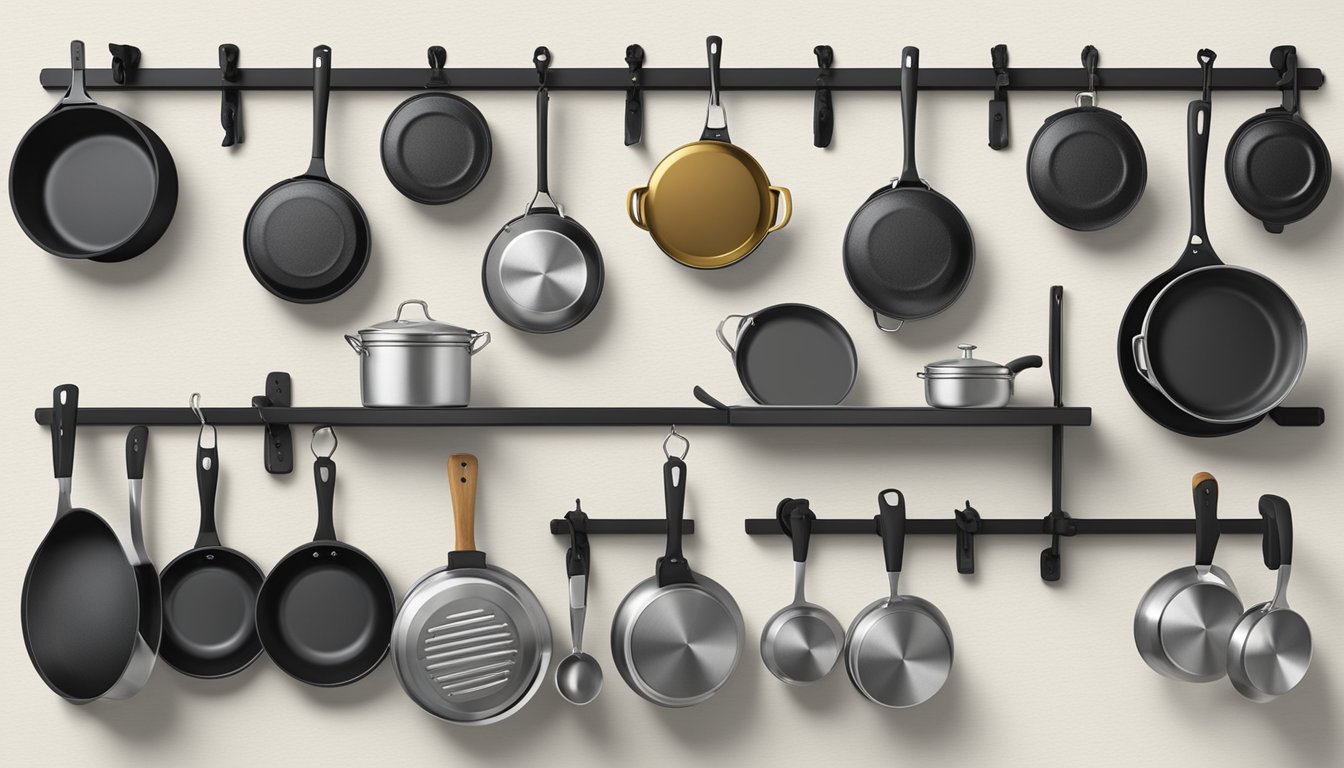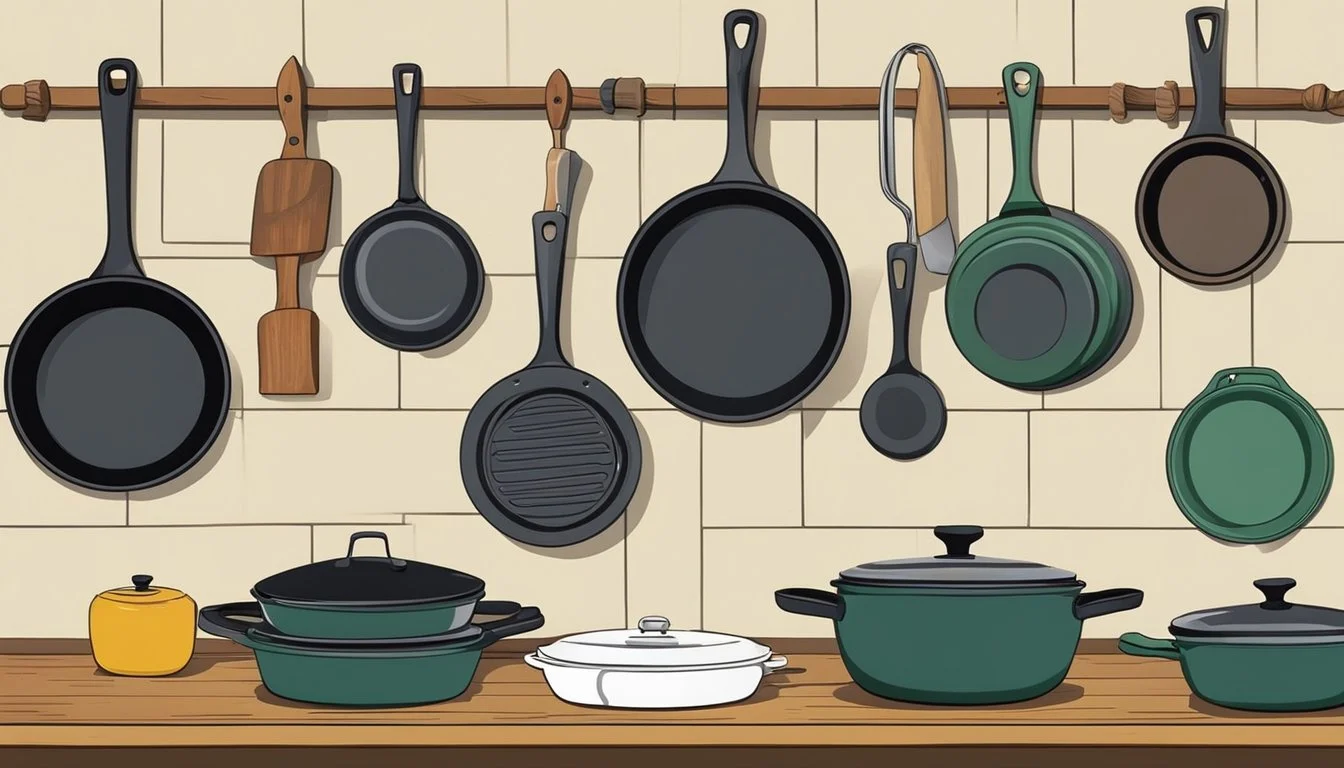Cast Iron Cookware as Decor
Creative Ways to Showcase Your Skillets
Cast iron cookware has long been treasured for its durability and versatility in the kitchen, but it also possesses a unique aesthetic appeal that makes it an ideal candidate for home decor. With its classic design and rustic charm, displaying cast iron skillets, pans, and pots can add a functional yet stylish touch to any kitchen space. By showcasing these culinary tools, homeowners can celebrate the merging of form and function, where practical kitchen implements become pieces of art that communicate a love for cooking and craftsmanship.
The art of arranging cast iron cookware as decor demands a mindful approach that considers both the visual impact and the practicalities of maintaining these pieces. While wall-mounted racks or shelves can transform a collection of skillets into striking wall art, hanging from a kitchen rail offers a more dynamic arrangement that combines ease of access with visual flair. Strategic placement of cast iron pan displays can enhance not just the kitchen but also dining and living areas, infusing them with a homey, welcoming vibe.
Cast iron cookware adds a touch of rustic charm and warmth to any space, making it an exceptional choice for incorporating into home decor. The cast iron versatility extends beyond the kitchen, as these timeless pieces can be displayed to evoke a sense of heritage and tradition. Whether it's a well-loved skillet or a meticulously restored piece, cast iron cookware brings character and history to any room.
In addition to their decorative appeal, these pieces also serve as a reminder of the joys of cast iron community cooking and the connections forged over shared meals. Embracing the art of gourmet cast iron cooking and the pleasure of crafting delicious cast iron skillet pies adds an extra layer of significance to these decorative pieces, infusing the space with a sense of warmth and hospitality.
The process of restoring rusty cast iron can be a labor of love, and displaying these restored pieces honors the craftsmanship and heritage of cast iron cookware. Whether showcased in a kitchen or as part of a curated display, cast iron cookware as decor serves as a tribute to the art of cast iron BBQ techniques and the joy of preparing nourishing cast iron winter recipes.
The Appeal of Cast Iron as Decor
Cast iron cookware boasts a distinctive aesthetic and a rich history, making it an attractive addition to kitchen decor.
Aesthetic Character
Cast iron cookware carries an undeniable visual appeal. Its robust and rustic appearance imparts an edgy and masculine touch that suits a variety of decor styles, from traditional to modern industrial. The natural patina that develops on well-seasoned cast iron pieces adds depth and character, making each skillet or item not just a tool for cooking, but a piece of art to be displayed.
Historical Significance
Cast iron holds a significant place in culinary history. Cookware made from cast iron, especially pieces produced before 1957, is often considered vintage due to the timeless craftsmanship of companies renowned during the era. This historical context not only serves as a conversation starter but also contributes to the overall charm of the kitchen environment. Collectors and cooking enthusiasts alike value cast iron for this link to the past, displaying these items as a homage to the tradition of hearth and home.
Mounting and Displaying Basics
Mounting cast iron cookware not only showcases its beauty but also ensures easy access. The process involves selecting an ideal location and securing the cookware in a manner that supports its weight while being aesthetically pleasing.
Choosing the Right Space
When selecting the perfect space to display cast iron pans, one should consider both functionality and visual impact. A space near the stove or in the kitchen where the pans are accessible makes for a practical choice. Ideally, the display should be positioned away from high-traffic areas to avoid accidental bumps. It's essential to take into account lighting conditions to enhance the display’s visual appeal.
Securing the Cast Iron Safely
Tools and Materials: A stud finder, sturdy hooks, and appropriate screws are imperative for a secure mount.
Steps for Wall Mounting:
Locate Wall Studs: Using a stud finder, identify and mark the studs in the designated wall space. This ensures that the rack or hooks will have the necessary support to hold the weight of the cast iron cookware.
Attach the Rack/Hooks:
Pre-drill holes at the marked stud locations.
Screw in the hooks or mount the rack securely onto the wall, making sure that they are firmly anchored.
It is crucial to use hooks that are strong enough to hold the weight of cast iron, which can be quite heavy. 'S' hooks are commonly used for such purposes, and they should latch easily onto the cookware’s handle. For racks, ensure that the distance between each piece is sufficiently spaced to avoid clutter and overlapping.
Display Options and Ideas
Displaying cast iron cookware can transform functional kitchen items into decorative pieces that add charm and character to your kitchen. Below are specific ideas for showcasing your skillets in a way that is both stylish and accessible.
Wall-Mounted Solutions
For kitchens with limited storage space, hanging cast iron skillets on the wall can be a practical and attractive display option. Homeowners can install a mounted pot rack or use sturdy hooks to hang the skillets by their handles. This not only keeps the skillets within easy reach but also turns them into a focal point. It is essential to ensure the wall and hooks are strong enough to support the weight of the cast iron.
Example:
Hook: Industrial-grade hooks
Location: Above the stove or on a free wall
Skillet Orientation: Handle outwards, slightly angled
Ceiling-Hung Pot Racks
Ceiling-hung pot racks offer an excellent storage and display solution, particularly for collections of cast iron cookware. This option keeps countertops clear and skillets organized. Installation should be secure, with the rack ideally positioned over a kitchen island or counter to minimize the risk of accidents.
Installation Tips:
Securely anchor the rack to ceiling joists.
Evenly distribute the weight of the skillets.
Skillet Accessibility: Ensure the height allows for easy access.
Countertop and Shelf Displays
Placing skillets on open shelves or countertops is a simple display method that puts the cookware on show and within reach. This works well for skillets frequently used, but they should be properly seasoned to avoid rust. A rack or stand specially designed for cookware can prevent skillets from scratching the surface and help maintain organization.
Shelving Material: Wood or metal to match kitchen aesthetics.
Skillet Placement: Invert lids and stack skillets by size for space efficiency.
Incorporating Functionality
Displaying cast iron skillets is not just about aesthetics; it offers practical advantages. A thoughtful arrangement ensures these kitchen tools are both a focal point and readily available for use.
Accessible Cooking
When storing cast iron skillets, accessibility is key. They should be placed within easy reach to encourage regular use and to highlight their versatility in the kitchen. A common method is to hang skillets from a kitchen rail or a sturdy hook setup, situated close to the cooking area. This not only saves space but also allows for swift selection when switching between different pans for various dishes.
Hanging Options:
S-hooks: Secure and easy to move.
Decorative chains: Adds a visual appeal.
Decor Meets Utility
The dual role of cast iron skillets as both functional cookware and decorative elements means that their placement should bridge the gap between decor and utility. Mounting them above the stove or on an accent wall within the kitchen or pantry integrates the skillets into the decor while keeping them in the functional realm. It is advisable to maintain a balance where the utilitarian purpose is not overshadowed by the displayment.
Balancing Tips:
Neutral location: Avoid high traffic areas to reduce risk of accidents.
Ease of cleaning: Position skillets where they can be easily removed for cleaning and seasoning, thus maintaining their finish and functionality.
Maintenance of Displayed Cookware
To maintain both the functionality and the aesthetic appeal of displayed cast iron cookware, regular cleaning and prevention of rust and damage are paramount.
Regular Cleaning
One can maintain the integrity of a cast iron pan by incorporating regular cleaning. After each use, it should be gently cleaned with warm water and a soft brush or sponge. Avoid using soap, as it can strip away the valuable seasoning that has built up over time. For stubborn food remnants, it may be necessary to boil a small amount of water in the pan to loosen the particles. After washing, dry the cookware thoroughly to prevent rust and apply a thin coat of oil to protect the surface.
Preventing Rust and Damage
The seasoning on cast iron cookware not only improves its non-stick qualities but also protects against rust and damage. To prevent rust, one should always dry the cookware completely immediately after cleaning. If the pan is not in use, it's essential to store it in a dry environment. Occasionally re-seasoning the pan reinforces its protection. This maintenance involves lightly coating the cookware with a neutral oil and baking it in an oven at 375°F for about an hour. To avoid damage, refrain from stacking pans directly on top of each other unless they are separated by a layer of paper towel or cloth to prevent scratches.
Enhancing Your Display with Accessories
When it comes to accessorizing your cast iron cookware display, the right hooks and storage add-ons can marry functionality with aesthetic appeal. These accessories should be chosen for their durability and complementary style to the cast iron pieces they will support.
Decorative Hooks and Hangers
Choosing the right hooks and hangers is essential for a display that is both attractive and practical. Cast iron hooks offer sturdy support for heavy skillets and come in a variety of designs that enhance the rustic charm of the cookware. For a touch of elegance, one might consider:
Forged iron hooks with intricate scrollwork
Minimalist, industrial-style hooks that emphasize clean lines
When opting for wall storage, securing hooks into wall studs assures that the display can safely bear the weight of cast iron pans. Additionally, magnetic knife strips can be repurposed as magnet solutions to attach lid covers or utensils that complement the pans.
Add-ons for Storage Expansion
For cooks who need to maximize space, add-ons like a storage tower or wall organizer are ideal. These solutions not only increase capacity but can also be an attractive feature in the kitchen:
A storage tower with shelves: Used to stack and display pans by size
A multi-tier organizer: Perfect for hanging multiple skillets and doubling as a feature wall
The use of expandable racks or over-the-cabinet door organizers can further enhance storage, keeping countertops clear and the cookware within easy reach. Whether hung from a pot rail or displayed on a shelf, the addition of the right accessories elevates both the form and function of cast iron cookware as decor.
Selecting and Featuring Statement Pieces
Displaying cast iron cookware is not just about storage but also about making a style statement in the kitchen. Cast iron pieces, with their classic look and durability, can serve as both functional cookware and conversation-starting decor.
Spotlight on Signature Skillets
A signature skillet, notably from reputable brands like Lodge or Butter Pat Industries, offers both quality and visual appeal. To feature a skillet as a statement piece:
Highlight craftsmanship: Look for skillets with distinguishing features such as a polished finish or intricate detailing on the handle.
Accessibility: Position the skillet where it’s easily reachable, such as on a magnetic wall mount or a hanging pot rack.
Showcasing Dutch Ovens
Dutch ovens are as versatile in function as they are in display potential. To showcase dutch ovens effectively:
Mix and match: Combine dutch ovens of different sizes and colors from a single brand to create a cohesive but visually interesting display.
Elevate the staple: Turn a well-seasoned Lodge dutch oven into the focal point on a shelf or in a glass-front cabinet where its robust form and rich patina can be admired.
Choosing the Right Cookware for Display
When selecting cast iron cookware for display, one should consider both the cookware's historical value and its visual appeal. The pieces chosen will contribute to the space's ambiance, reflecting a balance between functionality and aesthetic charm.
Antique versus Modern Cast Iron
Antiques:
Pros:
Character: Antique cast iron pans often have a unique patina that tells a story of their history.
Durability: These pieces have stood the test of time, indicating robust construction.
Cons:
Availability: May be harder to find in good condition.
Price: Tend to be more expensive due to their age and rarity.
Modern:
Pros:
Condition: Newer pans are usually in better condition, with a sleek appearance.
Selection: There's a wide variety of modern cast iron cookware on the market.
Cons:
Personality: They may lack the unique characteristics of older pieces.
Assessing Aesthetics and Condition
Aesthetics:
Design: Look for pans that have distinctive shapes or patterns.
Finish: A well-seasoned skillet has a glossy sheen that is visually pleasing.
Condition:
Surface: Check for a smooth cooking surface since roughness can detract from display appeal.
Integrity: Ensure there are no cracks or warping, as structural soundness is important, even for display.
Thematic Styling and Decor Integration
Incorporating cast iron cookware into home decor requires a thoughtful approach to align them with the existing kitchen style and create a visually cohesive appearance. Subtle touches and strategic placements can transform these culinary tools into statement pieces.
Matching with Kitchen Decor
When integrating cast iron skillets into kitchen decor, one should focus on the compatibility with existing color schemes and materials. For a rustic or industrial look, cast iron pieces fit seamlessly with wooden features or metallic accents on countertops and cabinet hardware. A farmhouse kitchen, with its natural hues and textures, can be enhanced with skillets hanging from a reclaimed wood pegboard, while a modern kitchen may benefit from cast iron accents displayed on minimalist shelves.
Color Matching: Pair with complementary colors.
Material Coordination: Align with kitchen hardware and surfaces.
Creating a Cohesive Look
To achieve a uniform look, homeowners should consider the arrangement and accessibility of their cast iron pieces. Strategically placing skillets can highlight them as a statement piece without cluttering the space. Key factors include symmetry, spacing, and the use of thematic elements like hooks or stands to exhibit cookware.
Visibility: Place skillets where they can be seen but not obstructive.
Accessibility: Arrange for convenience in use and aesthetic appeal.
Symmetry & Spacing: Maintain balance and avoid overcrowding.
By paying attention to details and embracing the inherent character of cast iron cookware, one can achieve a balanced and integrated kitchen decor.
Conclusion
Incorporating cast iron cookware into home decor not merely enhances the aesthetic value but also underscores a practical approach to kitchen organization. For those who have amassed a collection, displaying skillets and pans offers easy access and celebrates the timeless quality of these culinary staples.
Maintenance is key; before showcasing, ensure each piece is well-seasoned with a neutral oil to protect against rust and to reinforce the classic patina that cast iron is known for. Such routine care allows the cookware to double as both functional kitchen tools and decorative elements.
Whether displayed on a sturdy kitchen rail, nestled on open shelves, or highlighted as part of a centerpiece, cast iron cookware lends a rustic yet refined touch to any interior. The prudent use of accessories like S-hooks and decorative chains adds to the ease of access, while also contributing to the kitchen's overall charm.
Smart placement near cooking areas enables functionality, allowing chefs to seamlessly transition from artful display to culinary action. As multiple approaches to display exist, the decision should reflect the cook's style and the kitchen's space needs. Home cooks can rest assured that with proper seasoning and care, their cast iron cookware will serve as both a reliable tool for delicious meals and a striking addition to their home's ambiance.







